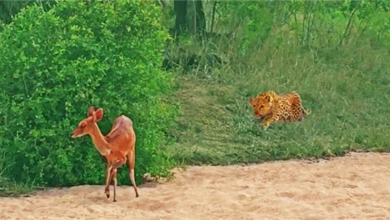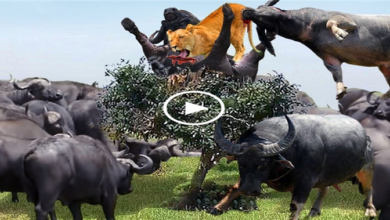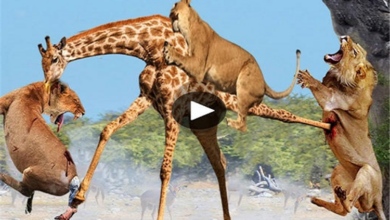
The hunt concluded swiftly as the lion tactically outmaneuvered its prey and delivered highly effective strikes, resulting in the defeat of a large-sized quarry. A gripping video captured within Kenya’s Maasai Mara National Reserve showcases a determined wildebeest fighting for survival against both hyenas and lions.
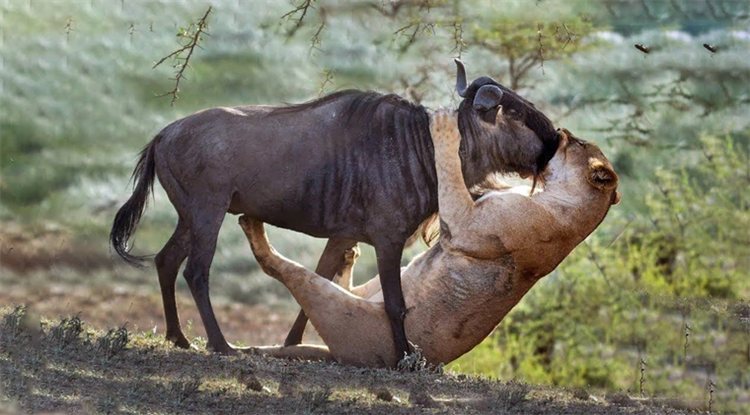
The footage begins with the antelope under attack, surrounded by hyenas clamping their jaws onto its tail. Just as the battle rages on, a male and female lion suddenly appear on the scene. The hyenas, recognizing their “natural enemy,” promptly retreat, leaving the wildebeest behind.
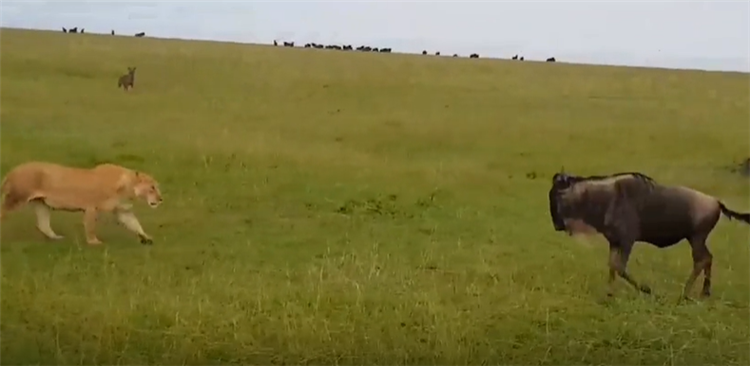
At this juncture, the antelope has ample opportunity to flee toward its herd. However, it chooses to engage the lion, employing its sharp horns in an attack. Underestimating the enemy’s prowess, the antelope is swiftly overpowered by the lion duo in an instant.

The lioness demonstrates her exceptional hunting skills by deftly rolling to the ground and then subduing her prey in a prone position. This maneuver enables the lions to evade the lethal thrusts and hooks of the antelope’s horns while swiftly accessing the vulnerable throat area. As the female lion seizes the antelope by the neck, the male lion pounces from behind, using his strength to bring the creature down lifelessly.
The hunt concludes promptly as the lion employs meticulous tactics and highly effective strikes, enabling them to conquer a formidable quarry. Despite being classified as endangered on the IUCN Red List since 1996 and experiencing a population decline of approximately 43% since the early 1990s, lions continue to establish themselves as the dominant predators on the European grasslands.

Referred to as the “king of the jungle” or the “king of beasts,” lions often emerge victorious due to their distinctive body structure. Males can weigh up to 250 kg, while females reach weights of up to 182 kg, making them the second-largest felids after the Northeast Asian tiger within the Cat family.
Furthermore, lions frequently exploit their numerical advantage when targeting herbivores or solitary mammals that have strayed from their groups, facilitating easier hunting endeavors. Consequently, they can efficiently take down large animals such as plains zebras, wildebeest, wild buffalo, Gemsbok antelope, giraffes, adult hippos, and even African bush elephants.
When operating individually, they pursue smaller prey such as antelopes (Connochaetes), bovids (family Bovidae), gazelles (genus Gazella), hares, and African warthogs (Phacochoerus africanus).

Typically, lion hunts are brief and highly efficient. When hunting alone, they dispatch their prey by clamping onto the neck to fracture it or disrupt the circulatory system. When hunting in groups, lions employ a coordinated approach, with some gripping the larger quarry while others attack the neck or suffocate the prey by restricting its breathing. Lions can also incapacitate their quarry by sealing off the victim’s nostrils, leading to asphyxiation.
On average, lions can consume up to 30 kg of meat per hunt. If they cannot consume the entire carcass, they rest for a few hours before resuming their meal. Even during feeding, lions capitalize on their numerical strength to safeguard their “feast” from scavengers like vultures and hyenas.


